U.S. sales of new Class 8 trucks declined slightly in October, according to figures received from ACT Research. During the month, 19,034 trucks were sold, compared with 19,380 trucks in September, a 1.8% decline. Compared with October of last year, sales declined 18.5% from the 23,346 sold.
It’s not that 2020 is a bad year for truck sales. It’s that 2019 was an exceptionally good year.
“The comps on sales are very tough right now,” said Kenny Vieth, ACT’s president and senior analyst. “Sales are not weak; they just look bad compared to the monster numbers the industry was putting up last year.”
Of the trucks sold this October, 14,402 (75.7%) were over-the-road tractors equipped with fifth wheels. The remaining 4,632 were vocational trucks equipped with dump, trash, concrete or other bodies. Vocational truck sales consumed a larger share of the market than normal for the first six months of 2020, peaking at 45.4% of new trucks sold in May. Since then, the percentage has declined, reaching just 23.7% in August before rebounding slightly.
Vieth believes the COVID-19 pandemic plays a part in that decline.
“A lot of trucks are purchased by municipalities and other government entities,” he explained. “With shutdowns and unemployment due to COVID, those local governments are hurting for tax revenues. They don’t have money to spend.”
One of the surest ways to predict future truck sales is to look at orders for new trucks. ACT reported 39,100 trucks ordered in October on the North American market, far more than can be produced in a single month.
FTR reported preliminary numbers of 40,100 Class 8 trucks ordered during October. Don Ake, FTR’s vice president of commercial vehicles commented in a press release, “Fleets became much more confident about future freight demand and began placing large orders to replace older units and for expansion purposes, as capacity tightened. In just a few months, the industry has gone from fear, to hope, to optimism.”
Tractors weren’t all the trucking industry was buying. ACT reported in a Nov. 12 release that 54,200 trailers were ordered in the U.S. during October, an increase of 68% over orders received in October 2019.
“Fleet commitments over the past two months have now pushed the industry backlog to the highest level since June of last year,” said Frank Maly, ACT’s director of commercial-vehicle transportation analysis and research. “Increases in both freight volumes and rates, along with capacity challenges, have influenced fleets to aggressively enter the market.”
Maly predicts that the current backlog of trailer orders will, at current production rates, take until next July to build.
While order numbers and backlogs suggest strong sales well into 2021, there are positive economic factors, too. Spot freight rates are hovering at or near record levels, even though freight levels are down compared to last year. That normally doesn’t happen — but circumstances are different this year. Carriers are reporting a driver shortage again, making it difficult to seat the trucks they’re buying. COVID-19 could be part of the reason for that as well.
As trucks were parked during shutdowns and restrictions due to COVID-19, some of the aging driver workforce simply retired. Government supplements to unemployment benefits provided additional incentive for those who didn’t officially retire to stay home. And, there’s another factor. The FMCSA’s Drug and Alcohol clearinghouse has made it more difficult for drivers to work who have a positive drug or alcohol test on their record. The number of states that have legalized recreational marijuana hasn’t reduced the chances of driver consumption, either.
A vaccine for the COVID-19 virus could do much to recharge the economy, said ACT’s Vieth. “The coiled spring of pent-up demand in manufacturing will eventually take off,” he noted. At the same time, the reopening of restaurants, bars and vacation destinations would stimulate the service side of the economy.
Looking at individual manufacturers, Peterbilt and Kenworth, the U.S. PACCAR companies, both increased sales over September results, as did International, according to numbers received from Wards Intelligence.
Kenworth sales of 2,859 were a 2.1% improvement over 2,850 sold in September, but 14.2% behind sales of 3,332 in October 2019.
Peterbilt’s 2,699 sold in October bested September sales of 2,686 by 0.5% and only 13 trucks. Compared to October 2019, sales were down 21.6% from 3,444.
International saw its best sales month of the year for Class 8 trucks, selling 2,377 of them in October. Although October sales weren’t close to October 2019 sales of 4,609 (a 48.4% decline), they were still 5.4% better than the 2,256 sold a month ago in September.
Western Star had a great month with sales of 484 trucks, an increase of 23.8% over September’s 391 and a 2.8% increase over sales in October 2019 of 471 trucks.
Mack sales of 1,077 represented a decline of 18.3% from September sales of 1,319. Compared to October 2019, sales declined 12.0% from 1,224.
Volvo’s October sales of 1,943 were only 0.9%, or 17 trucks, behind September sales of 1,960. Compared to last October, however, sales declined 13.8% from the 2,248 sold in that month.
Freightliner reported sales of 7,332 in October, down 4.9% from 7,713 sold in September and down 4.4% from 7,673 sold in October 2019.
As for the share of the new Class 8 U.S. market each manufacturer controls, Freightliner leads them all with 37.3%, up from the 36.8% it held at the same point last year. Kenworth’s 15.3% of the market is up from the 14.7% held last year. Peterbilt’s 14.5% is next, down from 14.8% at the end of October 2019. International holds 12.5% of the new Class 8 market, down considerably from the 14.8% held at the same point of 2019. Volvo, with 9.9%, has gained over last year’s 9.4%, while Mack rests at 7.4%, up from 7.2% last year.
With the announcement that Volkswagen’s heavy truck unit, Traton SE, has purchased remaining stock in Navistar for $3.7 billion, a transition to better days may be in the cards for International.
Trucking is poised for a great 2021, with Class 8 truck sales expected to continue an upward trajectory. The biggest problem may be in finding drivers for all of those trucks.
Cliff Abbott is an experienced commercial vehicle driver and owner-operator who still holds a CDL in his home state of Alabama. In nearly 40 years in trucking, he’s been an instructor and trainer and has managed safety and recruiting operations for several carriers. Having never lost his love of the road, Cliff has written a book and hundreds of songs and has been writing for The Trucker for more than a decade.
















Morning thoughts 🤔
Excellent article Cliff. Stories of new truck sales unfortunately are triggers that effect a large number of wannabe and newer truckers. Influencing this industry demographic that will talk themselves into believing they need to lease or try and buy a new truck.
Thinking they are missing out. Many people unfortunately act out irrationally evidenced every time this business cycle goes a sudden surge in rates.
Secondly As profit potential increases similar to what we experienced most recently in 2018.
I foresee a significant increase in the operating cost for truck owners. Items and services for support such as parts, shop labor rates, parking, tolls, and other supplies.
And IMO there’s likely going to be increases in fuel cost plus fuel tax cost.
The EPA mandates are going to need funding these clean air subsidies and grants awarded to large companies are not beneficial to many small owners who often end up being penalized if they want to upgrade they are left out because only the big players have the political connections.
This also has the potential to reduce the FSC payments many rely on as companies take the position; that you should buy that new truck that may increase your MPG from 6.5-7 to 9-10.
Ask yourself will an improvement of 2 MPG pay for that additional cost? What is the return on your equipment investment now and in the future?
Many questions for the truck owners that are going to need answers.
Respectfully
Gary Buchs